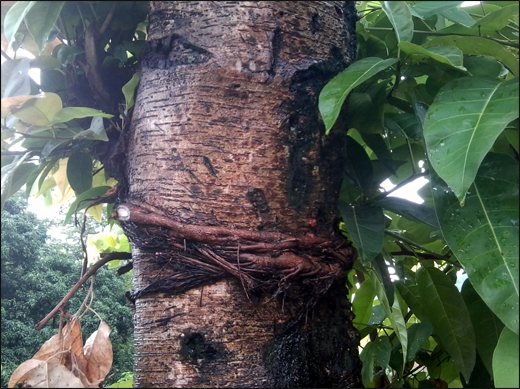Java Fig/ Ficus lacor Buch. – Ayurvedic Properties, Practical Uses, Parts Used & More
Abstract
Ficus lacor is a significant evergreen tree in Ayurvedic medicine, known for its diverse therapeutic uses and ecological importance. It has been traditionally used to treat various disorders, ranging from respiratory issues to digestive disturbances. With a rich presence of phytochemicals, it contributes to both preventive and curative health practices. This species is native to the Indian subcontinent and widely recognised for its immunomodulatory and anti-inflammatory properties. Its bark, leaves and fruits are used in many classical and folk remedies. The tree also plays a vital role in agroforestry and soil conservation due to its extensive root system.

Introduction
Ficus lacor belongs to the Moraceae family and is revered in Indian culture for its medicinal, spiritual, and environmental contributions. It is commonly known as the “Plaksha” tree in Ayurveda, it is one of the sacred fig trees mentioned in ancient Vedic texts. Traditional healers use different parts of the plant in formulations to manage conditions such as ulcers, cough, diarrhoea and urinary tract disorders. In addition to its therapeutic relevance, the tree is also employed in ritualistic practices. Its presence in sacred groves and temple complexes further highlights its cultural value. Modern pharmacological studies have also validated many of its traditional uses.
Scientific Classification
- Kingdom : Plantae
- Division : Magnoliophyta
- Phylum : Tracheophyta
- Class : Magnoliopsida
- Order : Rosales
- Family : Moraceae
- Genus : Ficus
- Species : Ficus lacor Buch.-Ham.
Synonyms
- Ashwattha Patraka – Leaves resemble those of the Bodhi tree (Ficus religiosa)
- Charudarshana – A gigantic and beautiful tree
- Mahabala – Extremely strong
- Drudhapraroha – Having firm growth, strong roots and stem
- Mangalacchaya – Considered auspicious
- Hrasvaparna – Having short leaves
- Parkati
- Jati
- Pippari
- Pimpari
- Shrungika
- Vaati
- Gardabhanda
- Kamandalu
- Plava
- Gandhamunda
- Mugdhika
- Pugamunda
- Charudaru
- Suparshva
- Kapeetana
- Kapeetaka
- Varoha Shakhi
Vernacular Names
- Hindi : Pakar, Pakadi
- English : Java Fig
- Gujarati : Pepari
- Kannada : Basari mara
- Malayalam : Chela
- Marathi : Basari
- Tamil : Jovvi
- Telugu : Juvvi
Habitat
Ficus lacor is widely distributed across tropical and subtropical regions of the world. Its natural range includes countries such as Australia, Southeast Asian nations, Bhutan, Myanmar, India, Indochina, and Nepal. While it can grow on various soil types, optimal growth occurs on moderately deep soils with sufficient moisture availability. The tree shows a certain degree of frost tolerance; however, young seedlings are highly susceptible to damage from grazing and fire. In Nepal, Ficus lacor is commonly found up to an altitude of approximately 1600 meters, particularly in the central and western regions. Notable locations include Kathmandu, Lalitpur, Bhaktapur, Kavrepalanchok, Sindhupalchok, Rasuwa, Nuwakot, Dhading, Bara, Parsa, Rautahat, Makwanpur, Chitwan, Ramechhap, Gorkha, and Dolpa.
Morphology
Plaksha is a medium to large-sized tree commonly found in the temperate regions of India. It has pale brown bark and leaves that are 4–5 inches long, ranging in shape from kidney-shaped to oval, with 6 to 10 prominent veins. The tree bears small, round fruits that are pale red to whitish in colour. Both fruits and flowers typically appear between April and June.
Varieties
There are three varieties of Ficus lacor, which are as follows:
- Var. infectoria
- Var. lambertiana
- Var. wightiana
Classical Categorisation
- According to Charaka Samhita:
- Mutra sangrahaniya – Herbs that increase urine volume
- Kashaya skandha – Astringent tasting group of herbs
- According to Sushruta Samhita: Nyagrodhadi gana
- According to Bhavprakash Nighantu: Vatadi Varga
- According to Vagbhata: Nyagrodadi gana
- According to Dhanvantari Nighantu: Amradi varga
- According to Kaiyadeva Nighantu: Oushadhi varga
- According to Raj Nighantu: Amradi varga
Ancient Verses
प्लक्षः कषायः शिशिरो व्रणयोनिगदापहः । दाहपित्तकफास्त्रघ्नः शोथहा रक्तपित्तहृत् ॥
(Bhavprakash Nighantu Vatadi varga 12)
According to the above shloka, Plaksha has astringent taste, cold potency and balances Pitta and Kapha dosha. It is effective in the management of wounds, vaginal diseases, burning sensation, bleeding disorders, inflammation and hematemesis.
Ayurvedic Properties
- Taste (Rasa) : Astringent (Kashaya)
- Physical property (Guna) : Heavy (Guru), Dry (Ruksha)
- Potency (Veerya) : Cold Potency (Sheet)
- Post-digestion effect (Vipaka) : Katu (Pungent)
- Effect on tridosha : Balance Pitta and Kapha dosha
Therapeutic Properties
- Daha : Burning sensations, such as those experienced in gastritis, neuropathy, or burning in the eyes
- Asra : Blood-related disorders, including abscesses, skin diseases, and bleeding conditions like menorrhagia or nasal bleeding
- Meda : Excess body fat, obesity
- Shopha : Inflammatory conditions and swelling
- Murcha : Fainting spells or temporary loss of consciousness
- Shrama : General fatigue, exhaustion, or tiredness
- Pralapa : Delirium or incoherent/irrelevant speech
- Vrana : Wounds, ulcers, or open sores
- Yonigada : Gynecological issues such as vaginal infections, excessive menstrual bleeding, or uterine disorders
Systemic Actions
External Application
Possesses wound-healing, anti-inflammatory, and blood-cleansing properties. Bark powder is beneficial in managing various inflammatory conditions, bleeding disorders, skin ailments, and wounds. It can also be used as a gargle for relief from mouth ulcers.
Internal Administration
- Nervous System : Useful in conditions like dizziness, anxiety and restlessness
- Digestive System : Acts as an absorbent and is helpful in controlling vomiting and diarrhoea
- Circulatory System : It helps in the management of bleeding disorders
- Reproductive System : Effective in managing female reproductive issues such as leucorrhea and excessive menstrual bleeding
- Excretory System : Helps reduce excessive urination and is beneficial in diabetic conditions
- Tapakrama (Febrile Conditions) : Alleviates burning sensations (Daha Prashamana)
Chemical Composition
- β-sitosterol
- Stigmasterol
- Campesterol
- Lupeol
- α-amyrin
- β-amyrin
- α-hydroxyursolic acid
- Oleanolic acid
- Ursolic acid
- Maslinic acid
- Bergaptol
- Bergapten
- Scutellarein
- Scutellarein glucoside
- Infectorin
- Sorbifolin
- Ornithine
- Alanine
- Tyrosine
- Methionine
- Lactose
- Sucrose
- Galactose
- Acid Detergent Fibre (ADF)
- Neutral Detergent Fibre (NDF)
- Vitamin C
- β-carotene
- Alkaloids
- Tannins
- Flavonoids
- Saponins
- Phenolic compounds
Modern Overview
Anti-inflammatory Activity
Various extracts of Ficus lacor aerial roots, such as ethyl acetate, petroleum ether, ethanol, and chloroform, have shown significant anti-inflammatory activity in experimental studies. These extracts were tested using carrageenan-, histamine- and serotonin-induced paw oedema models in animals and were found to exhibit effects comparable to standard anti-inflammatory drugs like Indomethacin and Pyrilamine. Among the different extracts, the ethanol extract at a dose of 100 mg/kg demonstrated the most promising results, with 75.40% inhibition in carrageenan-induced oedema, 68.72% inhibition in serotonin-induced oedema, and 74.01% inhibition in histamine-induced oedema. These findings support the traditional use of Ficus lacor in managing inflammatory conditions and suggest its potential as a natural anti-inflammatory agent.
Anthelmintic Activity
The anthelmintic activity of Ficus lacor bark was evaluated using petroleum ether, chloroform, ethanol, and aqueous extracts against Eiseni afoetida earthworms. Among these, the ethanol and chloroform extracts exhibited superior efficacy compared to the standard drug piperazine citrate (10 mg/ml). At a concentration of 150 mg/ml, both extracts were more effective in inducing paralysis and causing the death of the earthworms. This suggests that Ficus lacor possesses significant anthelmintic properties and may serve as a natural remedy for helminthic infections.
Hepatoprotective Activity
The hepatoprotective activity of the ethanolic extract of Ficus lacor bark was evaluated against carbon tetrachloride (CCl₄)-induced liver toxicity in albino rats. The study assessed the protective effect of the extract by measuring key biochemical markers, including Serum Glutamate Pyruvate Transaminase (SGPT), Serum Glutamate Oxaloacetate Transaminase (SGOT) and total bilirubin levels. The results showed a significant reduction in all these parameters in the extract-treated group when compared to the CCl₄-intoxicated control group, indicating that the ethanolic extract of Ficus lacor possesses notable hepatoprotective properties.
Practical Uses
- Wound care: Fine powder of dried bark is sprinkled over wounds and bleeding sites to aid healing and control bleeding.
- Oral health: Decoction of the bark is used for gargling to treat mouth ulcers and gingivitis.
- Digestive and reproductive health: Bark decoction (50–70 ml) is given to treat diarrhoea, leucorrhoea and to help manage blood sugar levels in diabetes.
- Neurological support: Cold infusion prepared from the bark is used to treat nausea, vertigo and epileptic seizures.
- Skin conditions: Paste made from the bark is applied externally on herpes lesions and wounds to reduce inflammation and support healing.
Part Used
- Bark
- Latex
Dosage
Decoction – 50-100 ml
Conclusion
Ficus lacor is a highly valued tree in Ayurveda for its holistic therapeutic benefits. Its versatile applications in treating digestive, respiratory, urinary and skin conditions underscore its importance in traditional medicine. Scientific research continues to explore its bioactive components, reinforcing its relevance in modern herbal pharmacology. With its sacred stature and medicinal utility, Ficus lacor remains a vital botanical resource for health and ecological balance.



